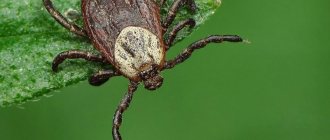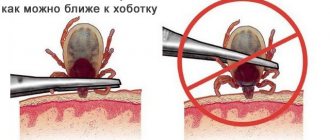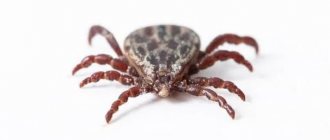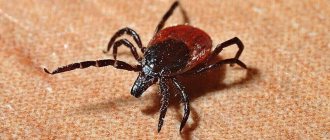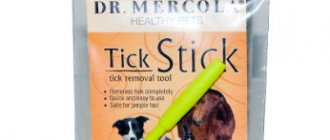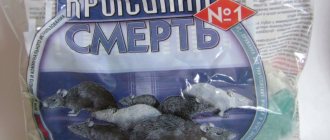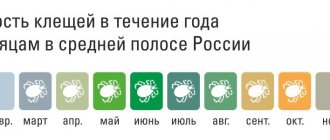With the arrival of spring, when the snow has almost melted and nature wakes up from sleep, the period of fighting ticks begins for owners of four-legged friends. Many people wrongly believe that they are found only in rural areas, and large cities are also subject to their invasion. In addition to protecting yourself, it is important to prevent the parasite from biting your pet as well. What to do if your dog is bitten by a tick - you must act immediately, try to remove the tick immediately, or take the animal to the nearest veterinary clinic.
Ticks cause diseases in dogs, the symptoms of which are not always immediately noticed. A dog's reaction to a tick bite is often completely absent. Therefore, after a walk, you should check whether the dog has a tick. In this case, remove the parasite as soon as possible. Find out what to do if your dog has a tick. How to help your pet and properly remove a tick from a dog? What to do if a tick breaks off? How long does it take for tick-borne disease symptoms to appear after a tick bite in dogs? What are the complications?
Signs of a tick bite in a dog
How can you tell if your dog has been bitten by a tick? Infectious ticks cause diseases in dogs, the symptoms of which are not always immediately noticed by the owners. Therefore, after walking with your pet, you should always check if the dog has ticks, looking for small lumps or something like pustules.
The tick can be as tiny as a sesame seed (the tick is tiny right after a dog bite, don't expect a big one drunk on blood). If your dog is found to have a tick, remove the parasite as soon as possible.
Due to its small size (about half a centimeter), recognizing a tick is not an easy task, especially in dog breeds with thick hair, such as the Pomeranian. After walking, it is important to conduct a very thorough examination of the pet. You can carefully comb your fluffy dog with a furminator in order to have time to remove the tick sitting on the fur, which has not yet had time to bite the dog.
The attached parasite immediately begins to suck blood and approximately doubles in size. If you discover a dangerous find and there are no veterinarians nearby, you need to take everything into your own hands and take decisive action.
It is advisable to always have medical gloves, disinfectant liquid and tweezers in your arsenal - this is a basic set. It’s great if you have a special lasso or device for extracting ticks, which can be purchased at pharmacies and veterinary clinics.
Biology of the pathogen
Piroplasmosis is provoked by Babesia, which replace two hosts during the entire development cycle. The first are ticks. Infection occurs through the bite of a sick animal. Dogs become infected after eating a sick parasite.
Babesia enter the bloodstream and begin to actively divide. Single-celled microorganisms develop in red blood cells and feed on hemoglobin. After some time, they begin to transform, getting into the stomach.
On a note!
In ticks, parasites are contained in large numbers in the saliva, so when bitten they enter the blood en masse. Babesiosis in dogs develops rapidly; the clinical picture directly depends on the animal’s body’s defenses.
What does a tick bite look like in dogs?
Where do ticks bite and where can I find embedded parasites on my pet? Ticks like dark, moist areas on the body, so look for them, especially in the ears, under the collar, under the tail, between the toes, on the elbows and under the armpits. A dog can even have mites on his eyelids. The mark of a tick bite on a dog looks like a kind of compaction, like a bump with redness.
It should be remembered that ticks are found not only in forests, but also in parks and city gardens - these parasites especially love tall grasses, forest edges and fields. Ticks come to life in the spring, in March - April, and remain active until October or November, depending on the temperature. Therefore, a tick bite is a common occurrence and can be treated at home, i.e. removing the parasite is possible and even necessary. It is better to use a special tool for removing ticks, purchased in advance from a pet store.
Feeding a sick animal
To weaken the effect of toxins, it is important not only drug treatment, but also a gentle diet, followed until complete recovery (1-2 months):
- Avoid fatty foods. Feed your dog chicken, oatmeal and beef tenderloin.
- Avoid repeated reheating. Serve warm food, prepared exactly at the time of feeding.
- Provide your pet with enough fresh and clean water . To boost immunity, fortified rosehip decoctions are suitable.
Try to avoid excessive physical activity. The maximum load during treatment is leisurely walks over a short distance.
First aid for a dog with a tick bite
What to do if your dog is bitten by a tick? If your dog has a tick, remove the parasite as soon as possible. Dog ticks are removed in the same way as human ticks, i.e. The tick must be grabbed with tweezers or a special lasso (sold in a pharmacy) and carefully removed with a rotational movement.
Do not pinch the tick's body with tweezers, as this may cause its contents to get under the skin. Then make sure the head is completely removed. Before treatment, you should not smear the tick with anything, try to tear it, crush it, etc. After you have removed the parasite, observe how the dog behaves.
The extraction procedure is not as complicated as it seems, but it will require endurance and patience from you:
- Initially, find a well-lit room.
- The entire procedure must be carried out strictly with gloves to avoid infection.
- Under no circumstances should you sharply pull out a parasite that has already become embedded, since due to the harpoon-shaped proboscis, the head can remain in the dog’s body and cause complications.
- Using the tool, you need to grab the tick’s body as close to the dog’s body as possible and slowly begin to rotate clockwise. Please be patient, the procedure may take several minutes.
- If extraction is successful, the tick must be destroyed. The priority is to burn it or place it in a chemical solution. It is strictly forbidden to press him.
- If there is a suspicion that the pet has become infected, the parasite must be packaged in an airtight container and taken to the veterinarian to be tested for infections.
- Treat the extraction site with a disinfectant solution. Regular alcohol will do just fine.
If you don’t have tweezers or a pincer, you can use a strong thread. Make a loop out of it, grab the tick as close to the dog’s body as possible and slowly pull out the parasite using pendulum-like movements, it will soon come off.
If you have a syringe at hand, you can use it. Cut the end of the syringe, lubricate the area of contact with the skin with cream and begin to slowly pull out the plunger. Due to the formation of a vacuum, the insect will become detached over time.
To prevent tick bites, there are a number of special means, such as a special collar, special drops and shampoos, and sprays. Sold in almost any pet store.
What should you do if the tick breaks off during removal and the head of the tick remains in the dog’s body? In such a situation, it is best to contact a veterinarian as soon as possible.
Diagnosis of piroplasmosis
The diagnosis of piroplasmosis should be made only by a veterinary specialist, using a number of laboratory tests. First of all, the doctor will conduct a clinical examination of the sick dog, but since the symptoms of the disease may be weak or absent altogether, the following methods are prescribed:
- Clinical and biochemical blood test to detect Babesia in erythrocytes.
- Polymer chain reaction for parasite antigen detection.
- Urine analysis to determine the color of biological fluid and the presence of hemoglobin in urine.
- Examination of an ixodid tick removed from a dog’s body for the presence of parasites in the bloodsucker.
In some cases, repeated diagnosis may be required, since in the initial stages of the disease the presence of Babesia in the blood cannot be established.
Symptoms of a tick bite in a dog
What can tick bites lead to, and what symptoms does a pet exhibit? The main danger is that these blood-sucking insects carry various dangerous infections that can cause death. Among them are encephalitis, borreliosis (Lyme disease), granulocytic anaplasmosis and many, many others. Each disease has its own symptoms and treatment. Therefore, before you understand how to treat a dog after a tick bite, it is necessary to correctly determine the diagnosis.
It is very important to identify the presence of the parasite as quickly as possible and, if possible, contact a veterinarian; the slightest delay is fraught with possible complications and the prospect of long-term and expensive treatment.
Treatment
The professional approach to the treatment of piroplasmosis in the Russian Federation and abroad is different.
The European approach is to inject an imidocarb-based drug if symptoms of piroplasmosis occur. The dog is monitored for 2 weeks. If your pet is feeling good, there is no need to do anything. Otherwise, the injection is repeated. Imidocarb protects the dog from subsequent arthropod attacks.
If the first injection coincides with darkening of the urine, an antimicrobial drug containing Doxycycline, Azithromycin or erythromycin is prescribed. Antibiotics destroy synergistic microflora. After completing the course, the dog is temporarily transferred to veterinary food with prebiotics to restore digestion.
In Russia, a different treatment regimen has been adopted. Diminazene aceturate derivatives are mainly used. To maintain the function of the liver, kidneys, and heart, maintenance therapy is carried out through droppers. Antibiotics are widely used. Veterinarians practice additional injections of antiprotozoal drugs. The liver suffers. The situation is corrected with hepatoprotectors.
I recommend using Hill's l/d high-calorie and low-protein veterinary nutrition for the treatment of liver pathologies to restore digestive functions.
Despite the dissimilarity of symptoms and pathogens, the treatment regimen for bartonellosis, borreliosis and ehrlichiosis is approximately the same. In all situations, a course of antibiotic therapy with Doxycycline is used.
If the causative agent of the disease is protozoan microorganisms, an injection of Imidocarb is given. General strengthening agents, hepatoprotectors, and B vitamins are used.
To restore digestive functions, use Hill's l/d or Royal Canin Hepatic medicinal food.
What are the diseases of dogs after a tick bite?
Babesiosis.
Babesiosis is a particularly dangerous disease for dogs. If left untreated, your dog can die in just a few days. Symptoms after a tick bite in dogs appear after 1-3 weeks and include:
- heat
- drowsiness
- anorexia
- vomit
- in some cases, the urine is red-brown in color (“rusty urine”)
There may also be atypical forms of the disease associated with bleeding and disseminated intravascular coagulation syndrome, which can be accompanied by severe motor, neurological, visual, digestive and vascular disorders.
Treatment should begin immediately after the diagnosis of babesiosis is confirmed.
When a dog has a tick, there is a risk of contracting a tick-borne disease. The consequences of a tick bite for a pet can be very dire. Infection can lead to complications including interstitial pneumonia with dyspnea, renal dysfunction, glomerulonephritis, arthritis, polymyositis, severe encephalitis, heart failure, and palsy due to cranial nerve damage.
Ehrlichiosis.
If a dog is bitten by ticks, the animal may become infected with ehrlichiosis. Ehrlichiosis is an animal disease, less common in humans, caused by rickettsia (bacteria) of the genus Ehrlichia and transmitted by ticks.
During the acute phase of canine monocytic ehrlichiosis, which lasts approximately 1-3 weeks, the first signs in dogs develop:
- the animal feels unwell
- apathy appears
- lack of appetite
- dyspnea
- fever
- lymphadenopathy
- enlarged spleen
- ecchymosis and bleeding on the skin and mucous membranes, nosebleeds,
- vomit
In the subclinical (latent) phase, which can last for weeks or months, dogs appear normal. Therefore, a dog’s behavior when bitten by a tick often does not change and does not cause suspicion.
Chronic canine monocytic ehrlichiosis is characterized by very complex symptoms. I see:
- weakness
- apathy
- persistent weight loss
- hyperthermia
- lymphadenopathy
- enlarged spleen
- peripheral edema in the hind legs
- pallor of the mucous membranes
- predisposition to bleeding with ecchymoses on the skin and mucous membranes
- mucopurulent inflammation of the eyes
- nosebleeds and hematuria
The most common treatment regimen is tetracyclines, of which doxycycline 10 mg/kg body weight over 3-4 weeks is the most commonly used treatment regimen. In the acute form, a blood transfusion may be required, as well as taking hematopoietic drugs.
Anaplasmosis.
If a tick bites a pet, there is a possibility that it will become infected with a disease such as anaplasmosis (until recently, it was part of the group of ehrlichiosis). Anaplasmosis is a disease caused by infection with the gram-negative bacterium Anaplasma phagocytophium, transmitted by ticks (usually from the genus Amblyomma and Ixodes).
There are two forms of the disease in dogs:
Canine granulocytic anaplasmosis - signs of infection include:
- sudden onset of drowsiness
- fever
- lameness (uneven movement caused by straining one (or more) sore or stiff limbs)
- pallor of the mucous membranes
- tight stomach
- diarrhea
- vomiting
- petechiae
- rapid breathing
- enlarged spleen
- lymphadenopathy
- rarely - cough
- uveitis
- swelling of the limbs
- excessive thirst
- neurological symptoms
Cyclic thrombocytopenia in dogs - symptoms include:
- fever
- drowsiness
- pallor of the mucous membranes
- petechiae
It is often asymptomatic.
It has been suggested that the Golden Retriever and Labrador Retriever are breeds that may exhibit increased susceptibility to infection by the pathogen that causes anaplasmosis in dogs.
As with ehrlichiosis, tetracyclines are the most commonly used treatment, of which doxycycline 10 mg/kg body weight over 3–4 weeks is the most commonly used treatment regimen. In the acute form, a blood transfusion may be required, as well as taking hematopoietic drugs.
Bartonellosis.
Bartonellosis is an infectious disease caused by the bacteria Bartonella bacilliformis. They are transmitted not only by ticks, but also by fleas and mosquitoes.
Dogs can become infected from Rhipicephalus sanguineus ticks, which carry Bartonella, and through direct contact with an infected animal or an environment contaminated with Bartonella.
Clinical signs of disease are rare in dogs infected with Bartonella after a tick bite. This is usually asymptomatic and the dog’s condition does not change. However, in some cases, the disease may become obvious and symptoms may develop that affect various organs, such as the heart (endocarditis, myocarditis).
Therefore, treatment is recommended only for animals that show symptoms. In this case, the dog is prescribed antibiotics.
Lyme disease.
The disease, called Lyme, is caused by the spirochete Borrelia burgdorferi. About 95 percent of infected dogs with Lyme disease are asymptomatic. Others may develop “Lyme arthropathy,” characterized by limping due to damage to one or more joints. If a puppy is bitten by a tick and infected with Lyme disease, fragile puppies may be at higher risk of developing this type of polyarthritis.
In studies with experimentally infected dogs, it was found that antibiotic treatment did not clear the infection in all dogs. The drug of choice is doxycycline 10 mg/kg orally once daily for at least 1 month.
European tick-borne encephalitis.
European tick-borne encephalitis is a disease caused by the tick-borne encephalitis virus (tick-borne encephalitis virus). Also known as early summer meningitis and encephalitis.
There is a febrile form (lasting 3 to 7 days), an acute form (lasting 1 to 3 weeks) and a chronic asymptomatic form (lasting several months). When this disease is reported, Rottweilers seem to be the most common.
Symptoms of febrile and acute phases:
- fever
- lethargy
- apathy
Dirofilariasis.
Heartworm is a parasitic disease that can be transmitted to dogs by: being bitten by an infective tick. Adult D. immitis infections can cause severe and potentially fatal illness in dogs and cats. Adult heartworms live primarily in the pulmonary arteries, but are sometimes found in the right side of the heart and in nearby large vessels such as the anterior and posterior vena cava. Atypical areas of the brain, eyeballs, or aorta are rare, especially in cats.
Heartworm disease is usually chronic. Most dogs that have this disease do not show symptoms for years. They develop gradually and may begin with a chronic cough, followed by moderate to severe shortness of breath, weakness, and sometimes fainting after exercise.
In the future, with the development of congestive right ventricular failure, swelling of the abdominal cavity and, less commonly, of the extremities, accompanied by anorexia, weight loss and dehydration, may be observed. Damage to the arteries is usually more severe in dogs exposed to intense exercise; Sudden death rarely occurs and usually results from respiratory failure and progressive emaciation. Of course, if the dog is not treated, it dies.
Gradual elimination of larvae is carried out over 4-8 months. Dogs with vena cava syndrome must first undergo parasitic surgery and then drug treatment.
Enteritis in dogs: symptoms and treatment.
Mycoplasma.
Mycoplasmosis - until recently called hemobartonellosis - is a disease caused in dogs by the microorganisms Mycoplasma haemocanis, and in cats - Mycoplasma haemofelis.
During the course of the disease, the dog becomes lethargic, weak, its temperature rises, and its mucous membranes turn pale. Treatment uses antibiotics from the tetracycline group (doxycycline), which are administered for at least 3 weeks.
Possible complications
Consequences:
- lung enlargement;
- liver damage;
- ischemic brain damage;
- renal, heart failure.
Convulsions are rare and end in the death of the animal. Kidney failure is common, but if urine forms, there is a chance to save your pet.
Complications include the chronic course of piroplasmosis. After the disappearance of bright painful, unpleasant symptoms, complete recovery does not occur; parasites are present in the blood, gradually poisoning the pet’s body. With the next bite from an infected tick, an aggravation occurs.
Important!
In severe situations, several types of Babesia are found in the blood of dogs, which causes complications in many internal organs and systems. It is very difficult and expensive to cure an animal. There are also situations when a pet is sick, but it is impossible to establish a diagnosis based on tests.
Tick on a dog - how to prevent a bite?
Are you wondering how to protect your dog from tick bites? There are several ways:
- dog tick stain - in the form of a liquid that is applied with a pipette to the dog's skin. The drug penetrates through the sebaceous glands of the skin and hair follicles, from where it is released to the surface of the skin along with sebum. It creates a “shell” on the body that prevents parasites from feeding freely. It neutralizes them at the moment of direct contact with skin or hair. The dose depends on the dog's body weight. The drug must be used once a month.
- anti-tick collars for dogs - they work in such a way that the active substance contained in the collar is regularly released - “distributed” throughout the dog. A protective collar is an effective preventive measure in the fight against ticks or fleas. It contains a carefully selected composition of essential oils that act both additively and complementary to each other. Thanks to this, they effectively prevent parasites from being in the company of animals.
- Anti-tick tablets – Give your dog a scented tablet to swallow which will protect against ticks for the next three months.
- Ultrasonic repellents - the device sends ultrasonic signals that block the Haller organ of ticks. Ticks use the Haller's organ to target a host, and when it is blocked, they cannot hunt effectively. Range 1.5 meters. The device works for about 8 months, and sometimes 10-12 months (it cannot be turned off). It is enough to hang the device on the dog, for example, on a collar. The product is not waterproof.
Still, it is easier and cheaper to purchase a special product and prevent your dog from being bitten by ticks than to cure the disease later.
Prevention memo
Prevention of tick attacks on dogs and the diseases they carry is as follows:
- Destruction of the parasite in the natural environment. You cannot eliminate ticks in forests and parks at your discretion, but you have the right to carry out decontamination in your personal garden or summer cottage. The drug Medilis-Ziper ensures the destruction of parasites and protection against the appearance of new ones for 1-1.5 months. 12 ml of concentrate is consumed per hundred square meters. The cost of 0.5 liters of pesticide is 1200 rubles. In addition to the above, the following acaricidal agents are in demand: Argus Garden;
- Dobrokhim FOS;
- Dr. Klaus;
- Ram.
If you have any questions, I will answer in the comments.
Next: Large dog breeds with photos and names
Recovery period
The dog is greatly weakened by this type of disease, and during the rehabilitation period it requires rest and avoidance of physical activity for 2-3 days. The liver often suffers and the use of hepatoprotectors such as Essentiale, Thiotriozolim, Glutargin is mandatory. Iron supplements are required to restore the physiological form of blood according to the formed elements. We need to restore lost hemoglobin and red blood cells! General strengthening therapy - broth, diet porridge, boiled liver, spleen, bone marrow from large beef bones give very good results. If you use food, then special holistic food designed for this type of recovery period will come in handy.
Important! The dog will constantly be thirsty, make sure there is water in the bowl!
